 MGF
History
MGF
History MGF
History
MGF
History
| This page contains: | MGF Model Evolution |
| The A to F of the MGF | |
| Why is the MG TF called a "TF"? |
The first all-new MG for 32 years, the MGF was launched to critical acclaim at the 1995 Geneva Motor Show. Initial attention naturally focused upon the mouth-watering technical specifications of this land mark car for MG: the Hydragas suspension, exotic electric assisted power steering, mid-engine configuration and the award winning K-series engine that had been extended to 1.8 litres for this application (which on the VVC version had also acquired an ingenious variable valve timing mechanism). The styling of the car was judged a successful blend of old and new- with design cues harking back to the last of the MGBs, but with a stance that was uncompromisingly modern and forward looking.
As we look back now, we see what a superb piece of design the MGF represents: the essential stylistic elements endured with relatively few minor interior changes for six years and 77,212 vehicles (excluding pre-production vehicles) - before the F's first truly comprehensive face lift in 2002 to become the hugely successful TF, racking up sales of 41,635 units prior to MG Rover's demise in April, 2005. However, whilst the MGF had been left essentially cosmetically unchanged over the first six-year period, and the TF unchanged for its 3-year production run, there have been a number of special editions, new model variants and detail alterations- and these are summarised below:
|
MGF |
|||||
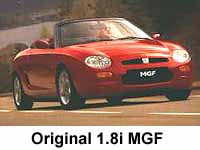 |
The Original MGF: 1.8i and VVC (1995-1999; VIN 000251-511058). Launched in 1995 as two models- the 1.8i and VVC, which possessed power outputs of 118 bhp and 143 bhp respectively. Standard equipment levels were good for the class of car: remote central & dead locking; passive arming immobiliser and remote activated perimetric and volumetric alarm (earning, in 1997, Thatcham Category 2 security status); electric windows and heated door mirrors. The VVC added further to this standard spec to include electrically assisted power steering (EPAS- which was to become standard on the 1.8i in 1998), ABS and half leather interior trim. | ||||
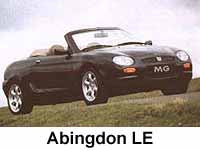 Legend has it this car is based upon the tweaks developed by Gerry McGovern for his own Tahiti blue car... |
The Abingdon LE (spring, 1998) was the first MGF special, limited-run edition, based upon both the 1.8i and VVC. The car's more luxurious specification included full ('Walnut' beige) leather upholstery, beige soft top and unique paint colour, Brooklands Green (a kind of dark, non-metallic British Racing Green). Other cosmetic extras include an interior and exterior chrome pack- chrome ashtray and lighter, chrome exterior door handles and stainless steel grilles. Also standard, and first seen on this car, were the 6 spoke 'Abingdon style' 16" wheels, fitted with Goodyear F1 (215/40 R16) tyres. The 16" wheels were soon to be found on the options list for all MGFs and have proven an extremely popular design! | ||||
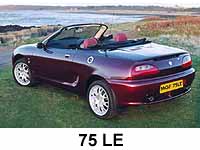 |
The 75 LE (March, 1999) was launched as a celebration model to commemorate the 75th anniversary of the MG car company (1924-1999). The specification of this model mirrored in many ways the earlier Abingdon LE with unique colours (Mulberry red and solid black) with leather and the fabric hood in a contrasting colour (black on red cars, red on black cars). Chrome interior and exterior highlights were as per Abingdon LE. Interestingly silver was a colour option offered in some markets (but not the UK). The 75 LE came with Multispoke design 16" wheels, and with either 1.8i or VVC engine options. | ||||
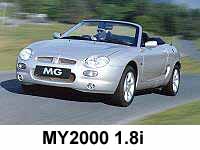
|
Mk2 / MY2000 MGF (1999-2002; VIN
511059-535576). Autumn of 1999 saw
the launch of the improved 'Model Year (MY) 2000' MGF models, that are also known amongst
MG enthusiasts as the 'Mk2'. The cars incorporated a number of detail improvements aimed
at eliminating some of the earlier car's weaknesses, including re-specified EPAS, double
skinned petrol tank and detail changes to the cylinder head location and gasket design.
Cosmetic and specification changes were few- what there were was aimed at improving the
ambience of the cabin- with the only external changes being the painting of the windscreen
surround in body colour where previously it was painted black, and the change of colour of
the front indicator units from orange to smoked-clear lenses. Thus the cars received new
seats designed to improve comfort and lateral support; the door trims now included an
alloy insert (or wood as an option), the centre console was redesigned with an alloy theme
incorporated (such as the gear lever surround) and improved switch gear. The heater
controls were now silver painted. Controversially, the instrument dials lost their 'MG'
logos, and the cream faces changed for silver items with a new italic type face.
Compensation arrived in the form of an improved six-speaker stereo, with a pair of
speakers behind the occupants' heads. VVC models retained their improved specification over 1.8i models. Where the 1.8i received new 8-spoke 'Minilite-style' wheels, the VVC received a new 16" 6-square spoke design. The interior is half leather, and the VVC, unlike the MPi, has ABS fitted as standard. |
||||
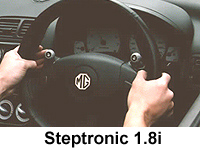 |
MGF Steptronic (2000-2002). Introduced a
little after the MY2000 models, the Steptronic cars received a technically advanced
continuously variable automatic transmission (CVT). This autobox includes a 'F1
paddle-shift' gear selection mode, that makes the gearbox operate as a six-speed
sequential gear box. The gears can be selected either by the gear lever (push or pull) or
the selector buttons on the steering wheel (pictured opposite). Unfortunately, this
gearbox is only available with the 1.8i engine, as the gearbox has an input speed limit
that is inadequate for the engine speeds that the VVC engine is capable of. Performance figures are broadly lower than the standard manual 1.8i (although it is argued that this car is at least as fast in the real world), whilst trim specs are close to VVC levels. |
||||
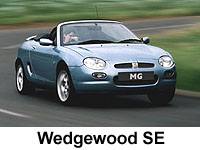 |
The Wedgwood SE (July, 2000) is the first limited edition based upon the MY2000 MGF. Following the successful formula struck by earlier limited editions, the car comes in a unique-for-MG colour, Wedgwood blue, and its improved standard specification includes leather seats, CD player, chrome interior and exterior accessories and 16" Multispoke wheels. This particular SE also possesses a rear deck spoiler- the first MGF to come so-equipped with it as standard. | ||||
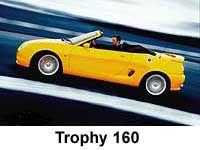 |
The Trophy 160 (May, 2001)-
so named because the re-tuning of the engine resulted in its VVC engine producing 160 PS
(158 bhp). Possibly the most exciting and most comprehensively re-worked MGF special
edition so far. The mouth watering spec includes lowered and stiffer suspension, AP racing
'MG' branded red coloured 4 pot brake callipers acting on significantly larger front brake
discs, a new aerodynamic package consisting of front splitter and rear deck spoiler and
that aforementioned engine. Other features include bold new colours- Trophy Yellow and Trophy Blue, a new style of 16" wheels and re-styled front head lamps. The interior has body coloured centre console and door trim inserts, plus coloured high-lights on the seats. Sure to be a classic. |
||||
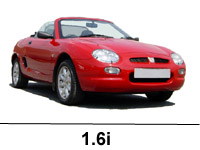 |
The MGF 1.6i (May, 2001) was launched somewhat quietly at the same time as its bigger, louder brother, the Trophy 160. Designed to compete at the other, cheaper end of the roadster market, the 1.6i competes head on with the similarly sized Mazda MX-5 (Miata). Compared to the 1.8i, the car is de-spec'ed: no central locking, no volumetric alarm, no radio, no power adjustable mirrors, no fancy trim inlays for the doors. The car is meant to be cheap fun. Despite the capacity deficit, the 1.6 K-series is a ballsy rev- happy engine. Such is its effervescent character, one doesn't notice the performance deficit! In other words it succeeds in its aim- it's fun! | ||||
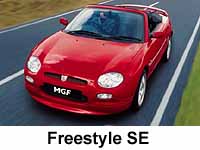 |
The MGF Freestyle (Autumn, 2001) was the last swan-song of the 'original' MGF before its radically face lifted replacement arrived in February 2002. Equipped with the cosmetic up grades already found on the MGF Trophy 160, the Freestyle thus came fitted with a Trophy-style front bib splitter and rear deck spoiler. The car also rides on 16" wheels, although this time using the familiar 'Multispoke' wheels featured on previous special edition MGFs. The Freestyle does without tuning upgrades found on the Trophy 160 or that car's superlative breaks, and as such is essentially based upon the standard model 1.8i and VVC. | ||||
|
MGTF |
|||||
 |
And now, the MG TF! (February, 2002 -
April, 2005; VIN 000101-641764) This car represents a dramatic stylistic departure for the MGF and includes a
huge number of engineering changes. These include a new suspension system (the car is now
sprung by coil-over damper units with a brand new multi-link rear) extensive body
strengthening, and a new faster 2.8 turn lock to lock steering rack to name but three. The
interior style is practically identical to the earlier MY2000 model, but now offers more
colour choice and material options. In many ways, the new TF deserves a new name,
although the 'T' prefix has caused some raised eyebrows in MG enthusiast circles. Click here for pictures comparing the MGF with the MGTF and click here for some detail pictures of the TF |
||||
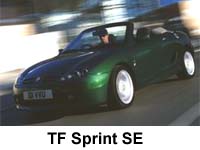 |
Sprint
SE (July, 2002),
based upon the TF 135 and 160 variants. The sprint SE had a high specification
trim from the outset, consisting of Gunsmoke Alcantara and black leather seats,
Smokestone fascia and door panels, a coloured hood, chrome pack and front fog lights. On TF
135 models, Sports Pack 2 (ABS, uprated 304mm front disc brakes and callipers and 16"
eleven-spoke alloy wheels – already standard on the TF 160) was specified as standard equipment. Only
600 MG TF Sprint models were said to have been
produced in the five colour available combinations: Solar Red, XPower Grey, Starlight
Silver, Le Mans Green and Trophy Blue. |
||||
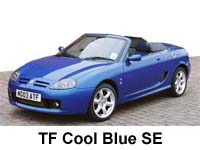 |
Cool Blue SE
(March, 2003), based upon
the TF 115 and 135 variants. The Cool Blue
SE is distinguished by its distinctive blue hood and unique Alcantara blue seats. All
models feature a Momo leather/alloy gear knob, leather steering wheel, wind stop and ash
grey fascia. The 'Cool Blue' SE features those staple [and very attractive] six-spoke
"Abingdon" 16" alloy wheels, found on so many previous MGF special
editions, along with standard fit chrome grille pack and front fog lamps. This SE is
available in a choice of three exterior colours: Trophy Blue pearlescent, Starlight Silver
or Anthracite metallic. |
||||
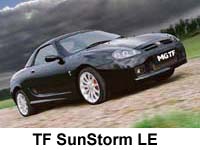 |
SunStorm LE (October, 2003), based upon the TF 115, 135 and 160 variants. Limited production run of 500. Offered in three body colour options - Raven Black, Nightfire Red and Starlight Silver. The standard-fit body-coloured hardtop is complemented by a Smokestone coloured interior and Gunsmoke Alcantara/ black leather seats, leather steering wheel, 'Momo' leather and alloy gear knob and a single slot CD tuner. The specification includes a black hood, bright pack, 16" 11-spoke alloy wheels and MG/AP Racing disc brakes as part of standard specification sportspack 2, front fog lamps and body coloured electric door mirrors. The Sunstorm SE is available with a choice of engines with three power outputs 115, 135 or 160Ps. | ||||
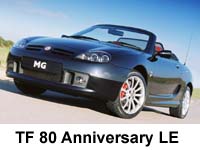 |
80th Anniversary LE (January, 2004), was launched in celebration of the MG marque's 80th anniversary. There were three exterior colour options: Pearl Black, Starlight Silver and Goodwood Green. All engine and transmission options were available. Interestingly, the silver and black anniversary models were trimmed differently from the green cars, with burgundy red hood, ash grey interior with grenadine Alcantara and black leather seats and bright-finish console, door casings, gear knob and handbrake grip. In contrast, the Goodwood Green Anniversary TF is more traditional in style, combining tan hood with matching tan interior and black Alcantara and tan leather seats. Wood effect inserts are fitted to the console, doors, gear knob and leather steering wheel. All models feature a folding windstop and CD tuner. 16" 11-spoke alloy ‘shadow chrome finish’ wheels are fitted, along with front fog lamps and bright door handles. Anniversary ‘1924 MG 2004’ logos are found on the boot lid and embroidered on the seats, which distinguishes the 80th Anniversary LE from other LE models. | ||||
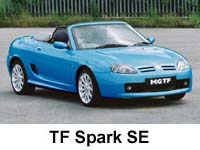 |
Spark SE (July, 2004), based upon the 115, 135 and 160 variants; 1000 produced for the UK market. The Spark SE falls into the now familiar TF SE pattern of offering the SP2 chassis option as standard on all models (AP brakes, 11-spoke shadow-chrome 16" wheels), along with Gunsmoke and Black Alcantara MG-logo embroidered seats in an Ash Grey interior and a Charcoal Grey hood. Uniquely, this SE offered an extensive 'alloy' effect interior trim finish on the door inserts and steering wheel, along with the usual 'Bright Pack' items: chrome ashtray and handbrake button, Momo leather/alloy gear knob, bright side and front grilles and chrome exterior door handles. Additional spec items include a windstop, front fog lights and a Sony CDX-2000 CD player. The Spark SE premiered Firefrost Red as a body colour and featured a unique Sonic Blue (pictured right) along with old exterior colour stalwarts, Xpower Grey and Starlight Silver. | ||||
|
|
Vintage Racing SE (October, 2004 -
France only), was launched at the October Paris motor show, 2004.
Based on the TF160, this car was painted in a unique colour scheme of Dover
White with French racing blue 'Cobra' style stripes - this special edition
is perhaps the most visually arresting of all the TF special editions
released.
|
||||
 |
2005 Model Year Update (Feb, 2005-April,
2005; VIN 637929-641764). The MY2005 version of the TF has brought with it a range of
modest, yet useful updates on the now classic theme. Those expecting a
dramatic facelift in line with the concurrent MG saloon range were
disappointed, but the upgrades meant :
The suspension too was re-rated with the aim to answer
criticisms of the earlier cars that incorporated softer springs, re-rated
dampers, thicker anti-roll bars and re-specified bushes. The net result was
a significant
smoothing of the occasionally bumpy ride that some owners with 16" wheel options
(particularly SP1 and SP2 option pack-equipped cars) complained of - without compromising the
much-admired handling sharpness. |
||||
|
MY2005 Production details:
*The MGF register has learnt that a significant number (253) 2005MY TFs were built during the PricewaterhouseCoopers administration period, but the VIN range this applies to, and which market these cars were supplied to are not presently known... enquiries and investigations are on-going. |
|||||
MGTF |
|||||
|
|
MGTF LE500
(September, 2008). After a long wait, here it
is - the new Longbridge-built MG TF - the LE500 - the '500' signifying the
number of cars in this series rather than any boast over engine power
output! The Nanjing-built TFs had already broken cover, being shown to the Chinese and world media in March, but there remained much anticipation as to what the UK cars would look like and how the specification would change in comparison to that seen on the old MG Rover built cars. On May 29th we found out - the new car's most striking feature being a very nicely re-designed front bumper, with styling reminiscent of Gerry McGovern's original, the MGF, with its twin 'nostril' intakes on either side of the octagonal MG badge and single large intake below the number plate. At the time of writing, many of the technical details of the new car had still to be confirmed, but the following is known: 
|
||||
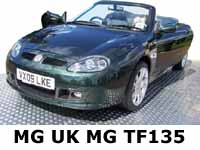 |
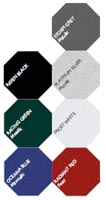 2009 model year 'standard' TF135
(April, 2009). With the credit crunch threatening the collapse of many
iconic international names in motoring (Chrysler at the time of writing
having just filed for chapter 1 bankruptcy), these have not been the best of
times to re-launch the famous octagon brand into a fragile market. Perhaps
this is part of the reason why MG UK have now launched the 'standard' model
TF. Devoid of such fripperies such as leather seats and reversing sensors,
the new model in the revised MG sports car range come in under the £14,000
price threshold, making this car one of the cheapest roadsters currently
available on the market. For those making use of the current scrapage
scheme, it could mean that you could be driving home from the showroom
having spent under £12,000 - incredible value! 2009 model year 'standard' TF135
(April, 2009). With the credit crunch threatening the collapse of many
iconic international names in motoring (Chrysler at the time of writing
having just filed for chapter 1 bankruptcy), these have not been the best of
times to re-launch the famous octagon brand into a fragile market. Perhaps
this is part of the reason why MG UK have now launched the 'standard' model
TF. Devoid of such fripperies such as leather seats and reversing sensors,
the new model in the revised MG sports car range come in under the £14,000
price threshold, making this car one of the cheapest roadsters currently
available on the market. For those making use of the current scrapage
scheme, it could mean that you could be driving home from the showroom
having spent under £12,000 - incredible value!
Colours included: Racing Green (Metallic), Platinum Silver (Metallic), Oceana Blue (Mica-tallic), Frost White, Radiant Red (Pearl), Raven Black and Storm Grey (Metallic) |
||||
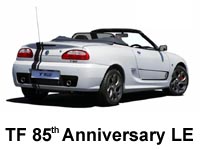 |
The MG TF 85th Anniversary LE (September, 2009). Perhaps the most evolved and developed of all the MGF derivatives, this was truly a special special edition. Unlike the SE/LEs that preceded it, this one was more than a hit and run into the MG accessories brochure, for it offers a number of engineering refinements not found on any other MG. Part of that package was a more honed suspension package, offering, for the first time, Bilstein monotube gas dampers and Eibach anti-roll bar sets. Geometry was hand checked by Ian Pogson's team as the cars moved along the production line for optimal bumpsteer characteristics. And the wheels by RimStock, in the attractive "Twist of Pepper" style offered different widths from front to rear (7J versus 7.5J respectively). Bespoke colours (Intense Cassis (Metallic), Ice White (Metallic) and Engimatic Silver (Metallic) - click here for colours) and contrasting graphics set this car off - and is, perhaps, the driver's choice of the whole range. It's a shame that the engine choice was so limited to just the 135ps N-series engine. Imagine it's potential with a 160ps VVC... | ||||
 |
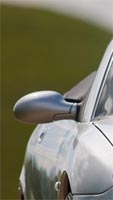 2010
Model Year TF135. These are the end of the line TFs before production
was finally wound up at Longbridge in May of 2010. Essentially the same as
the MY2009 version, these came with one important revision - the wing
mirrors. This investment was made to ensure vehicle homologation compliance
for sale in the EU, and are larger than the Rover 200-derived mirrors
previously employed on TFs and MY2000 MGFs. 2010
Model Year TF135. These are the end of the line TFs before production
was finally wound up at Longbridge in May of 2010. Essentially the same as
the MY2009 version, these came with one important revision - the wing
mirrors. This investment was made to ensure vehicle homologation compliance
for sale in the EU, and are larger than the Rover 200-derived mirrors
previously employed on TFs and MY2000 MGFs.These remain on sale in 2011 as I write this article, so there is still time to bag yourself one of the very last MG roadsters ever manufactured. It will be a small bit of automotive history, but the MGF and TF were the salvation of the brand. Without the MGF, it is perhaps difficult to imagine that there would still be an MG today. |
||||
| Why is an MGF called an MGF? There are two rival
explanations for the genealogy of the name. The first is that the same is simply a
marketing ploy, exploiting the positive associations between the letter 'F' and words like
'Fun'. But the name appears to have more logic to it than plucking a random letter and
placing it after the hallowed Morris Garages initials. The second explanation therefore, is that the F's name roots the modern MG into the marque's rich naming tradition. The 'current' naming system commenced with the launch of the first all new MG after the second world war- the MGA of 1955. The natural naming progression continued with that car's successor- the incredibly successful MGB, launched in 1963. A six cylinder variant of that car was launched in 1967. However, the MGC's life was short, being significantly outlived by the 4 cylinder MGB, which eventually ceased production (with the demise of the MG Abingdon plant at the hands of Sir Michael Edwards) in 1980. Behind the scenes however, long before the demise of the MGB, plans were afoot to replace the MGB/C. In the late sixties, the ADO21 project had been spawned. Based upon MGB underpinnings, but using an E-series engine pinched from the Austin Maxi mounted mid-ships, this car was to have been the first mid-engined MG- and probably the first affordable mid-engined sports car. Other elements of the design were dictated by the perceived risk of changes in US safety legislation- which was widely predicted to outlaw soft top convertible cars. Thus a targa design was alighted upon (similar in principle to the Fiat X1/9), with a flying buttress design that masked the height of the relatively tall engine. For better or for worse, that design did not get beyond the drawing board, as it lost out, in internal competition, to a design by Harris Mann for what was to become the Triumph TR7. However, whilst never seeing the light of day, this is the car what is popularly assumed to have acquired the MGD label. Interestingly, the mid-engine MG concept that was born with the MGD paper concept, was revived some 20 years later in the 1985 MG super car concept, the MG-EXE. Whilst never considered as a true production concept (the politics and image of the MG brand at the time ensured that the EXE stayed a motorshow fancy), the MG-EXE nonetheless was to have a profound influence upon the design direction of subsequent MG sports car concepts. An example of this influence can be seen in the rear lamp cluster design seen on the MGF- which is very reminiscent of those found on the MG-EXE. And so, having used the letters A through to E with either production cars or concepts for potential MGs, we arrive at the letter 'F'. And so it was, in 1995, that we saw the launch of the MGF- a name that surprised the motoring press of the time; the motoring pundits had widely predicted and fully expected the MGD tag for the car. Obviously there are gaps and discrepancies in this naming system. How does one fit in the MGB GT V8? Or the MG revival car, the MG RV8? And if one riffles through the 'secret' design proposals for potential MGs, one finds that the MGF tag had already been used- on the MG F-16 (the car that formed the basis for the later PR3 front/ front drive, mid/ rear drive and front/ rear drive development hacks used to evolve and hone the engineering concepts and parameters used in the car that we now know as the MGF). Which means of course, the most likely and plausible explanation for the MGF's name is, perhaps disappointingly, a marketing ploy- but one that at least has a certain logic and one that is based on the heritage of the world famous MG marque. Quite how the naming lineage will continue has only just become clear; it was always unlikely that the MG-G name would be used- primarily because in the UK 'Gee-gee' is a popular slang word for a race horse! So now we bid 'hello' to the new MG TF! |
` |
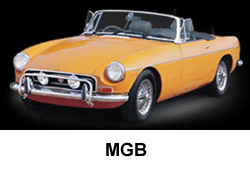 |
|
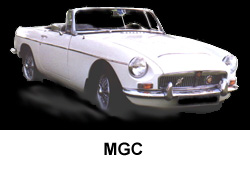 |
|
 |
|
 |
|
 |
Why is the MG TF called the "TF"?
This question is the subject of some debate in MG circles, where the name of a new MG carries more than average interest. As shown in the picture montage below, the TF name has already been used in a family of vehicles- the T-series Midget. This family lineage started before the war with the initial 'TA'. Without development funds being immediately available in the post war period, the design was further evolved with the TD and finally the TF in the early Fifties. Indeed, as stated in the MGF(TF) release literature, this was the last time that MG concurrently launched a sports car (the T-series) and a sports saloon (the Z-series).

The problem for MG enthusiasts is that the new TF bares no relationship with the earlier TF. In fact this is the first time an MG nameplate has been re-used. This may seem silly to some, but many are uncomfortable with this precedent. For me, it causes some confusion in writing this article, ensuring that you, the reader, knows which TF I am talking about! Personally, I feel that it is a little sad that the marketing team couldn't have come up with a better name than "TF". There are plenty of alternatives one could have used, and it seems more logical to continue with the "ABC..F" lineage discussed above. I guess this could be one of those arguments that could be set to run and run... but ultimately, the driving of the car counts more than the minor issue of names! Let the fun continue!


|
A little update to this naming debate - I had a chance to chat to Rob Oldaker about why the MGF was renamed at MGF10. As it turned out, it was a result of a board level discussion. There was a clear eagerness at board level to reflect the extent of the engineering changes that had been implemented for the new car - and the easiest way to achieve this recognition was to give the car a new name. Why TF? Well, according to Rob, because it "sounded right". And so, the MGTF was born. |